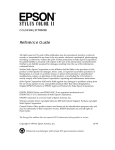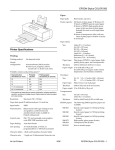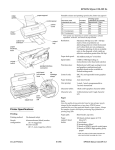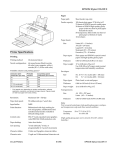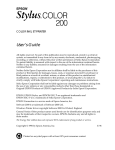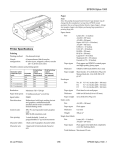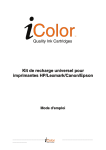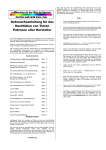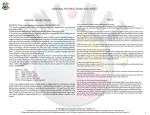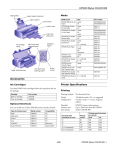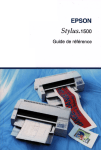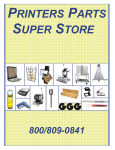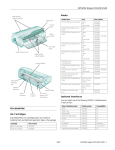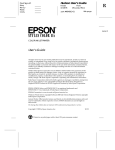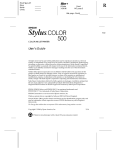Download Epson Stylus Color 200 Specifications
Transcript
EPSON Stylus COLOR 200 paper support edge guides Printable columns and printing speed*: Printing speed (characters per second) sheet feeder control panel printer cover * paper thickness lever power switch parallel interface connector print head unit release lever ink cartridge clamp Printable columns Normal Economy 10 80 125 167 200 12 96 150 200 240 15 120 188 250 300 17 (10 condensed) 136 214 285 342 20 (12 condensed) 160 250 333 400 Color Print speeds (in characters per second) are estimated for color printing on letter-sized paper and vary depending on system configuration, software application, resolution, and amount of page covered. Resolution: Maximum 360 dpi on a 720 × 720 dpi matrix. Dots are printed in an alternating pattern in which horizontal and vertical dots are non-contiguous. Contiguous printing of dots is available only on the diagonal, which yields an effective resolution greater than 360 dpi. Paper feed speed: 102 milliseconds per 1/6-inch line Input buffer: 2.5KB to 15KB depending on monochrome or color head unit selection Print direction: Bidirectional with logic seeking for text and graphics; unidirectional and autodirectional modes available in Default setting mode Control code: ESC/P 2 and expanded raster graphics code Paper feeding: Auto sheet feeder Line spacing: 1/6-inch, programmable in 1/360-inch increments Character tables: 1 Italic and 8 graphics character tables Character sets: 14 International and 1 legal character sets print head unit thickness adjustment lever Monochrome Character pitch (characters per inch) Printer Specifications Printing Printing method: On-demand ink jet Nozzle configuration: 64 monochrome (black) nozzles (16 × 4 staggered) 60 color nozzles (20 × 3, cyan, magenta, yellow) Ink Jet Printers 6/96 EPSON Stylus COLOR 200-1 EPSON Stylus COLOR 200 Paper Note: Since the quality of any particular brand or type of paper may be changed by the manufacturer at any time, EPSON cannot guarantee the use of any particular brand or type of paper. Always test samples of paper stock before purchasing large quantities or printing large jobs. Paper path: Sheet feeder, top entry Paper capacity: 100 sheets of plain paper at 17 lb (64 g/m2) 70 sheets of EPSON special coated paper 30 sheets of EPSON high-quality glossy paper* 50 transparency films* 10 envelopes Paper size: Letter (8.5 × 11 inches) A4 (210 × 297 mm) B5 (176 × 250 mm) Legal (8.5 × 14 inches) Statement (8.5 × 5.5 inches) Executive (7.5 × 10 inches) Paper types: Plain paper and special papers distributed by EPSON (high-quality glossy paper, special coated paper, and transparencies) Paper thickness: 0.003 to 0.004 inch (0.08 to 0.11 mm) Paper weight: 17 to 24 lb (64 to 90 g/m2); Use 24 lb (90 g/m 2) paper under normal temperature and humidity conditions. * Note: Poor quality paper may reduce print quality and cause paper jams and other problems. If you encounter problems, switch to a higher grade of paper. Print on special coated paper, high-quality glossy paper, envelopes, and transparencies only under these normal conditions: Temperature 59 to 77°F (15 to 25°C) Humidity 40 to 60% RH (High-quality glossy paper can be stored at 20 to 60% relative humidity.) Do not load curled or folded paper, envelopes, or transparencies. The following EPSON genuine papers are available: Special coated paper for 360 dpi printing (Letter) S041060 Special coated paper for 720 dpi printing (Letter) S041062 Special coated paper for 720 dpi printing (Legal) S041048 High-quality glossy paper (Letter) S041072 Transparency film (Letter) S041064 Iron-on transfer media (Letter) SE41001 Printable area: Single sheets A BL BR With one sheet of plain paper beneath the stack and printed one page at a time C Envelopes: Envelopes 9.5 × 4.1 inches (240 × 104 mm) 8.7 × 4.3 inches (220 × 110 mm) Size No. 10 DL Paper types Plain, bond, or airmail paper Paper thickness 0.006 to 0.02 inch (0.16 mm to 0.52 mm) Paper weight 12 to 24 lb (45 to 90 g/m2) A BL BR C Transparencies: (210 × 297 mm) (8.5 × 11 inches) Size A4 Letter Thickness 0.003 to 0.0033 inch (0.075 to 0.085 mm) A The minimum top margin is 0.12 inch (3.0 mm). Note: When printing multiple sheets of glossy paper, the minimum top margin is 1.2 inches (30mm) BL The minimum left margin is 0.12 inch (3.0 mm). BR The minimum right margin is: 0.12 inch (3.0 mm) for Statement and Executive paper 0.38 inch (9.7 mm) for Letter and Legal paper, and transparencies 0.15 inch (3.8 mm) for A4 paper 0.54 inch (13.8 mm) for DL envelopes 1.38 inches (35.1 mm) for #10 envelopes C The minimum bottom margin is 0.54 inch (14.0 mm). Note: Always load paper into the sheet feeder short edge first except envelopes. Load envelopes long edge first. EPSON Stylus COLOR 200-2 6/96 Ink Jet Printers EPSON Stylus COLOR 200 Ink Cartridges Mechanical Black ink cartridge (S020047): Paper feed method: Friction with auto/manual sheet feeder, top entry Color Black Print capacity* 540 pages (A4 paper; text) Total print volume: 25,000 pages Dimensions: Without paper support Width: 15.6 inches (396.7 mm) Depth: 8.1 inches (205.6 mm) Height: 5.7 inches (144.0 mm) Cartridge life 2 years from production date and up to 6 months after opening the package at 77°F (25°C). Temperature Storage: Transit: Freezing:** Dimensions With paper support –22 to 104°F (–30 to 40°C) 1 month at 104°F (40°C) –22 to 140°F (–30 to 60°C) 1 month at 104°F (40°C) 120 hours at 140°F (60°C) 26.6°F (–3°C) Width: 15.6 inches (396.7 mm) Depth: 8.1 inches (205.6 mm) Height: 10.5 inches (267.3 mm) Weight: 1.3 inches (W) × 2.3 inches (D) × 1.7 inches (H) 33 mm (W) × 58 mm (D) × 43.2 mm (H) Environmental Color ink cartridge (S020097): Colors Cyan, magenta, and yellow Print capacity* 320 pages (A4 paper; 360 dpi; 5% each color) Cartridge life 2 years from production date and up to 6 months after opening the package at 77°F (25°C). Temperature Storage: Transit: Freezing:** Dimensions * –22 to 104° F (−30 to 40°C) 1 month at 104°F (40°C) –22 to 140°F (−30 to 60°C) 1 month at 104°F (40°C) 120 hours at 140°F (60°C) 21.2°F (−6°C) Do not use an ink cartridge after the expiration date on the package. The printer comes with an installed set of fonts selectable using Default setting mode. However, the printer always uses the fonts you select with your software program. You need to select the printer’s installed fonts only when your software program does not allow you to select fonts. You can select other font and pitch combinations using ESC/P 2 commands. Rated frequency range: 50 to 60 Hz Input frequency range: 49.5 to 60.5 Hz 0.5A Power consumption: Approx. 15 W (ISO 10561 letter pattern) Ink Jet Printers FCC part 15 subpart B class B CSA C108.8 Fonts 103.5 to 132 V Rated current: 20 to 80% RH 5 to 85% RH (without condensation) Operation Storage* R.F.I.: Electrical Input voltage range: Humidity: Safety standards: UL 1950 with D3, CSA 22.2 950 with D3 The print capacity may vary depending on how often you use the print head cleaning function. Also, if you print large graphics and dense text with little white space, you use ink faster. 50 to 95°F (10 to 35°C) –4 to 140°F (−20 to 60°C) 1 month at 104°F (40°C) 120 hours at 140°F (60°C) Safety Approvals ** The ink thaws and is usable after approximately 3 hours at 77°F (25°C). c Temperature: Operation Storage* * Stored in shipping container 1.8 inches (W) × 2.2 inches (D) × 1.7 inches (H) 45.9 mm (W) × 56.5 mm (D) × 43.2 mm (H) Caution: Use only genuine EPSON cartridges and do not refill them. Other products may cause damage not covered by EPSON's warranty. 8.6 lb (3.9 kg) without the ink cartridge and print head unit 6/96 Scalable fonts Minimum point size Maximum point size Increments EPSON Roman 8 32 2 EPSON Sans Serif 8 32 2 EPSON Roman T 8 32 2 EPSON Sans Serif H 8 32 2 EPSON Stylus COLOR 200-3 EPSON Stylus COLOR 200 Bitmap fonts 10 cpi 12 cpi 15 cpi Proportional EPSON Roman yes yes yes yes EPSON Sans Serif yes yes yes yes EPSON Courier yes yes yes N/A Parallel Interface Specifications Signal pin Return pin 17 - CHASSIS GND - 18 - Logic H OUT 19–30 - GND - 31 30 INIT IN When this signal goes LOW, the printer controller is reset to its default state when the power is first turned on and the print buffer is cleared. This level is normally HIGH; its pulse width must be more than 50 µs at the receiving terminal. 32 29 ERROR OUT This signal level goes LOW when the printer: 1) Is out of paper 2) Is in an error state 3) Has no ink cartridge installed 33 - GND - Same as for Pins 19–30 34 - NC - Not used 35 - +5 V OUT 36 30 SLIN IN Signal Direction Your printer is equipped with an 8-bit parallel interface. Data format: 8-bit parallel, IEEE-1284 compatible mode Synchronization: STROBE pulse Handshake timing: BUSY and ACKNLG signals Signal level: TTL compatible Connector: 36-pin Centronics connector or equivalent Pin Assignments Signal pin Return pin Signal Direction Description 1 19 STROBE IN STROBE pulse to read data. 2 3 4 5 6 7 8 9 20 21 22 23 24 25 26 27 DATA 1 DATA 2 DATA 3 DATA 4 DATA 5 DATA 6 DATA 7 DATA 8 IN IN IN IN IN IN IN IN These signals represent information in bits 0 to 7 of parallel data respectively. Each signal is at HIGH level when data is logical 1 and LOW when it is logical 0. 10 28 ACKNLG OUT About a 5-µs pulse. LOW indicates data has been received and the printer is ready to accept more data. 11 29 BUSY OUT A HIGH signal indicates the printer cannot receive data. The signal goes HIGH in the following cases: 1) During data entry (for each character) 2) During initialization 3) During self test, demonstration, and default setting printing 4) During a printer-error state 12 28 PE OUT 28 SLCT OUT 14 30 AFXT IN Not used 15 - NC - Not used 16 - GND - Logic ground level EPSON Stylus COLOR 200-4 Printer's chassis ground, which is connected to the logic ground Not used Twisted-pair return signal ground level Pulled up to +5 V through 1 KΩ resistance Not used Notes: The column heading “Direction” refers to the direction of signal flow as viewed from the printer. “Return pin” denotes the twisted-pair return pin to be connected at signal ground level. For the interface wiring, be sure to use a twisted-pair cable for each signal and to complete the connection on the return side. All interface conditions are based on TTL level. Both the rise and fall times of each signal must be less than 0.2 microseconds. Data transfer must be carried out by observing the ACKNLG or BUSY signal. Data transfer to this printer can be carried out only after receipt of the ACKNLG signal or when the level of the BUSY signal is LOW. Reverse Channel A HIGH signal indicates the printer is in a paper-out state or in an error state. 13 Description Pulled up to +5 V through 1 kΩ resistance 6/96 Transmission mode: IEEE-1284 Nibble Mode Adaptable connector: 5730360 (Amphenol) or equivalent Synchronization: Refer to the IEEE-1284 specification Handshaking: Refer to the IEEE-1284 specification Signal level: IEEE-1284 level 1 device Data transmission timing: Refer to the IEEE-1284 specification Ink Jet Printers EPSON Stylus COLOR 200 Extensibility request: The printer responds to the extensibility request in the affirmative when the request is 00H or 04H, which means: Pin no. Signal name GND In/ Out 35 +5V — Out This line is pulled up to +5V through 1.0 kΩ resistance. 00H: 17 Chassis — — Chassis GND 16, 33, 19 – 30 GND — — Signal GND 15, 34 NC — — Not connected 04H: Request nibble mode of reverse channel transfer Request device ID in nibble mode of reverse channel transfer Reverse Channel Pin Assignments Pin no. Signal name GND In/ Out 1 HostClk 19 In Strobe pulse. Input data is latched at falling edge of the signal. 2 DATA0 20 In These signals represent information in bits 0 to 7 of parallel data respectively. Each signal is at HIGH level when data is logical 1 and LOW when it is logical 0. These signals are used to transfer the 1284 extensibility request values to the printer. Description 3 DATA1 21 In 4 DATA2 22 In 5 DATA3 23 In 6 DATA4 24 In 7 DATA5 25 In 8 DATA6 26 In 9 DATA7 27 In 10 PtrClk 28 Out Used to qualify data being sent to the host. Set LOW then HIGH to cause an interrupt indicating to host that data is available. 11 PtrBusy/ DataBit-3,7 29 Out Data bits 3 then 7 indicate forward channel busy status. 12 ACkDataReq / DataBit-2,6 28 Out Data bits 2 then 6. Set HIGH until host requests data transfer, then follows nData Avail (nFault). 13 Xflag/ DataBit-1,5 28 Out X flag signal and reverse channel transfer data bits 1 then 5. HostBusy 30 14 In The column heading “In/Out” indicates the direction of signal flow as viewed from the printer. Timing Chart BUSY ACKNLG DATA STROBE 0 µs (Min.) 0.5 µs (Min.) 0 µs (Min.) Set LOW to indicate that host can receive peripheral device to host data. Then set high to acknowledge receipt of that nibble. Set high in response to PtrClk (nAck) low pulse to re-enter reverse data transfer phase. 31 INIT 30 In Not used 32 DataAvail/ DataBit-0,4 29 Out This signal is LOW when the printer is in an error state. 36 1284-Active 30 In Set HIGH during 1284 mode. 18 Logic H — Out This line is pulled up to +5V through 3.9 kΩ resistance. Ink Jet Printers * Description 5 µs (Typ.) Note: Transition time (both the rise and the fall) of every signal must be less than 0.2 µs. Initialization The printer can be initialized (returned to a fixed set of conditions) in these ways: Hardware initialization • The printer is turned on. • The printer receives an INIT signal from the parallel interface: pin 31 goes LOW. Software initialization • Software sends the ESC @ (initialize the printer) command. The last panel settings are kept. Both initialization methods reset the font according to the default settings selected using the control panel. However, ESC @ does not initialize the printer mechanism, clear the input data buffer, or clear the user-defined character set. 6/96 EPSON Stylus COLOR 200-5 EPSON Stylus COLOR 200 Default Settings Error Conditions The table below shows the default settings that take effect when the printer is initialized. In addition, hardware and control panel initialization erases any text in the data buffer. Your printer’s control panel alerts you to printing errors. Check the table below to diagnose your problem using the control panel lights. Item Default setting Top-of-form position Current paper position Page length Set per the measurement taken at self test Left and right margins Cancelled Line spacing 1/6-inch line spacing Character pitch Last font selected using Default setting mode Vertical tab position Cleared Horizontal tab positions Every eight characters Font selection Last font selected using Default setting mode Special printing effects Cancelled (except economy printing) User-defined character set Hardware/control panel initialization: cleared Software initialization: deselected only Problem Ink Out Paper Out Ink low Flashing Off Ink out On Off Paper out Off On Paper jammed Off Flashing Print head unit or ink cartridge installation error Rapid flashing Off Carriage error On On Fatal error Flashing Flashing Buttons This section describes the control panel button functions and their functions in power-on sequences. Control Panel The printer’s control panel contains lights for displaying the printer status and buttons for controlling certain settings, as described in this section. Load/Eject Loads or ejects a sheet of paper. (The printer normally loads and ejects paper automatically.) Also used when you replace the ink cartridge or print head unit. Cleaning Starts a print head cleaning cycle. Button functions in power-on sequences Press these buttons while turning on the printer to perform the function described. The Ink Out and Paper Out lights flash briefly before the operation begins. Most printer settings can be controlled from your software, so you normally need to use the control panel only to do the following: Cleaning (Self test) Checks the paper length and performs a printer self test at 360 dpi. (Paper must be loaded in the printer.) Hold down Cleaning until the printer feeds the first page. Then press Load/Eject to print the next page. To stop the self test, wait until the second page prints and then turn off the printer. Load/ Eject (Demo page) Prints a demonstration page of the printer’s fonts and colors. (Paper must be loaded in the printer.) Hold down Load/Eject until the printer feeds a page. To exit demonstration mode, wait until the page prints and then turn off the printer. Load/ Eject then Cleaning (Nonsmear mode) Enables non-smear printing mode, which reduces the chance of smeared pages by decreasing the per-line printing speed. This mode is helpful when printing on coated or glossy paper because it allows more time for the ink to dry. Hold down Load/Eject as you turn on the printer; then press Cleaning while the Ink Out and Paper Out lights are flashing. Send a print job. To exit non-smear mode, wait until all pages print and turn off the printer. Clean the black or color print head Replace an ink cartridge or print head Print a self test or demonstration page. Lights Power On when the printer is on. Flashes while replacing the ink cartridge or print head unit, while cleaning the print head, and in certain error conditions. Ink Out Flashes when ink is low or during certain error conditions. On when the ink cartridge is empty or not installed. (The printer will not work when the ink cartridge is empty or not installed.) Paper Out On when the printer runs out of paper. Flashes if there is a paper jam or in certain error conditions. EPSON Stylus COLOR 200-6 6/96 Ink Jet Printers EPSON Stylus COLOR 200 Load/ Eject and Cleaning (Default setting mode) Cleaning then Load/ Eject (Hex dump mode) Enters the printer’s Default setting mode and prints an instruction page. (Paper must be loaded in the printer.) Hold down both the Load/Eject and Cleaning buttons while you turn on the printer; continue holding down the buttons until the printer feeds a page. To use Default setting mode without printing an instruction page, hold down Load/Eject and Cleaning, and turn on the printer; then press Load/Eject again. To exit the Default setting mode, wait until all pages print and turn off the printer. Prints a page containing a hexadecimal representation (hex dump) of the data received by the printer for troubleshooting purposes. (Paper must be loaded in the printer.) Hold down Cleaning as you turn on the printer; then press Load/Eject while the Ink Out and Paper Out lights are flashing. Send a print job. To exit hex dump mode, wait until all pages print and turn off the printer. Loading position. Determines the top margin by defining how close to the paper edge the first line can print. The loading position can be 3 mm or 8.5 mm (default). Normally you should use your software to adjust your top margin. Font and Pitch. Selects the built-in printer font and character pitch used as the default setting. The factory default pitch is 10 cpi; the default font is Courier. Generally you use your software to select the font and pitch. Thick paper. Select Envelope (default) if you print on thick paper or envelopes. Monochrome Print Speed. Sets a faster print speed when the monochrome print head unit is installed. The speed can be 167 cps (characters per second) or 125 cps (default). Economy. Turns on economy mode for printing rough drafts. With economy mode on, the printer uses less ink by printing fewer dots per character. (The default setting is off.) To turn on the Default setting mode and print instructions, turn off the printer. Then hold down both the Load/Eject and Cleaning buttons while you turn the printer back on, and keep holding down the buttons until an instruction page prints. Follow the instructions on the page to select a language; then press Load/Eject to print a second instruction page. Default Setting Mode Follow the instruction the printer prints to change the default settings by pressing buttons on the control panel. To exit Default setting mode, wait until printing stops, and turn off the printer. Additional printer functions are available through the Default setting mode. Because the printer’s factory default settings are designed to meet the needs of almost all users, you rarely need to change the additional printer functions listed below. If necessary, however, you can turn on the Default setting mode and change the settings using the control panel buttons. Charging the Ink Delivery System Character table. Selects the set of characters and symbols that can be printed. The default is the U.S.A. character table. If you commonly use a language containing accents, symbols, or other characters not available in the U.S.A. character table, change to a different character table. Print direction. Specifies how the print head moves across the page. The options are Uni-D, Bi-D, and Auto (default). When Uni-D is on, the print head prints in only one direction to provide the most precise alignment for graphics and text. In Bi-D printing, the print head prints in both directions. Bi-D is faster, but the vertical alignment may not be as precise as Uni-D. When Auto is selected, the printer switches automatically between Uni-D and Bi-D as necessary when it receives data. Network interface mode. If you’re having trouble printing when the printer is connected to multiple computers, turn on network interface mode. By default, network interface mode is off. Auto line feed. Specifies that a carriage return character encountered in the print file be accompanied by a line feed command. By default, auto line feed is off. If text lines print on top of one another, turn on auto line feed. Ink Jet Printers The printer comes with a color print head, installed in the printer, and a monochrome print head packed in the plastic storage box. When you want to print in color, install the color print head unit with the color ink cartridge in the printer. When you want to print in black, install the monochrome print head unit and black ink cartridge in the printer. Note: When printing a page that does not include color, using the black ink cartridge is faster and more economical. However, the color ink cartridge can print composite black. Composite black is a mixture of the inks in the color ink cartridge and closely resembles black ink. When you first set up the printer, you need to charge its ink delivery system by installing first the color ink cartridge and then replacing it with the black print head unit and cartridge. Follow the steps in this section. Note: Even if you don't plan to use the black ink cartridge immediately, you still need to install it to charge the ink delivery system. Once both ink delivery systems are charged, you can easily switch between color and monochrome printing as needed. 6/96 EPSON Stylus COLOR 200-7 EPSON Stylus COLOR 200 w c c Warning: The ink cartridges are self-contained units. Under ordinary use, ink will not leak from a cartridge. If ink gets on your hands, wash them thoroughly with soap and water. If ink gets into your eyes, flush them immediately with water. 4. Caution: Never move the print head by hand; always use the Load/Eject button to move it. Raise the ink cartridge clamp to open the print head unit. Caution: Do not open the ink cartridge packages until just before you install them or they may become too dry. ink cartridge clamp Installing the Color Ink Cartridge Follow these steps to install the color ink cartridge: 1. 2. paper sheet Make sure the printer is turned on. 5. Remove the protective paper sheet. 6. Open the foil ink cartridge packages and take out the cartridges. Remove the tape seal from the top of each one. Set the black cartridge aside for now. Raise the printer cover by lifting the edges, as shown below. color cartridge c 7. 3. Hold down the Load/Eject button for about five seconds until the print head moves slightly left, to the ink cartridge install position. The Power light begins flashing. EPSON Stylus COLOR 200-8 6/96 black cartridge Caution: You must remove the tape seal from the top of each cartridge; leaving the tape on will permanently damage a cartridge. Do not remove the clear seal from the bottom of the cartridge; ink will leak out. Lower the color ink cartridge into the print head unit with the label facing up and the arrow on the top of the cartridge pointing toward the back of the printer. Ink Jet Printers EPSON Stylus COLOR 200 8. Press down the ink cartridge clamp until it locks in place. You will feel some resistance. c 9. 4. Caution: Once you install an ink cartridge, do not open the ink cartridge clamp again or remove the cartridge except to replace it with a new one. Once you remove a cartridge, do not reuse it. Reusing a cartridge that has been removed may damage the print head. Press the Load/Eject button again to return the print head to its home position. (Even if you do not press Load/Eject, the print head moves back to its home position about 60 seconds after you close the clamp.) Grasp both sides of the print head unit and carefully lift it out of the printer. Place the print head unit on a flat, clean surface. c Caution: Do not touch the electrical contacts on the back and bottom of the print head unit or inside the printer; you may damage them. 5. Remove the monochrome print head unit from its storage box by pressing on the notch as shown. Place the color print head unit in the box. Always store the unused print head unit in this box to protect its delicate components. 6. Carefully insert the monochrome print head unit into the printer with the electrical contacts and print head facing the back of the printer. 7. Press down the print head release lever until it clicks into place. The printer charges the ink delivery system for about two minutes. During this time, the Power light flashes. When the printer is finished charging, the Power light stays on. c Caution: Never turn off the printer while the Power light is flashing. Installing the Black Ink Cartridge Follow these steps to remove the color print head unit and install the monochrome print head unit and black ink cartridge: 1. Make sure the printer is on and the printer cover is open. 2. Hold down the Load/Eject button for about five seconds until the print head unit moves left slightly to the ink cartridge install position. The Power light flashes. 3. Raise the print head unit release lever as far as it will go. release lever c c Caution: Do not lift up the ink cartridge clamp; the ink cartridge and print head may become unusable. Ink Jet Printers Caution: If the Power and Ink Out lights are flashing, remove the print head unit (beginning at step 3) and reinsert it. 8. Open the ink cartridge clamp and remove the protective paper sheet. 9. Lower the black ink cartridge into the print head unit with the label facing up and the arrow on the top of the cartridge pointing toward the back of the printer. 6/96 EPSON Stylus COLOR 200-9 EPSON Stylus COLOR 200 10. Press down the ink cartridge clamp until it locks in place. You will feel some resistance. thick paper setting 11. Press the Load/Eject button again to return the print head to its home position. (Even if you do not press Load/Eject, the printer moves the print head back to its home position about 60 seconds after you close the clamp.) After you install the black ink cartridge, the printer charges the ink delivery system. This takes about one minute. During this time, the Power light flashes. When the printer finishes charging, the Power light stays on. c Caution: Make sure the printer completes the ink charging process even if you plan to reinstall the color print head unit. If the charging process is not completed, the printer may be damaged. 12. Close the printer cover. c plain paper setting Caution: Never turn off the printer while the Power light is flashing. When you are ready to discard an ink cartridge, always remove it from the print head unit first. Do not discard the print head unit. You can load up to 100 sheets of plain paper in the sheet feeder. Be sure to load it with the printable surface facing up. The printable surface is marked with an arrow on most plain paper packaging. 1. Push down the left edge guide lock lever; then slide the left edge guide to the left as far as it will go. 2. Load the stack of paper, printable side up, so that its right edge rests against the right side of the sheet feeder. Do not load paper above the arrow mark inside the left edge guide of the sheet feeder. When you switch between print head units, always leave the ink cartridge installed. Once you remove a cartridge, do not reuse it. Reusing a cartridge that has been removed may damage the print head. Use only genuine EPSON ink cartridges and do not refill them. Other products may cause damage not covered by EPSON's warranty. When you want to print in color again, replace the monochrome print head unit with the color print head unit. Loading Plain Paper Checking the Paper Thickness Lever The paper thickness lever on the right side of the sheet feeder has two settings: plain paper and thick paper. Set the lever to the position that best suits the paper or other media you plan to use, as shown in the following table and illustration. Paper type Paper thickness lever position Plain or special paper Plain paper Transparencies Plain paper Envelopes or labels Thick paper EPSON Stylus COLOR 200-10 6/96 Ink Jet Printers EPSON Stylus COLOR 200 3. Slide the left edge guide against the left edge of the paper; then push up the lock lever to secure its position. When printing on high-quality glossy paper or transparencies, remove each sheet from the output tray immediately after it is printed. Make sure each sheet is dry before stacking. Return unused sheets and envelopes to their original package as soon as possible after you finish printing. Unfavorable storage conditions—especially high temperature, humidity, and direct sunlight—can damage the media. Follow any other special loading procedures included in the following sections. Loading Special Papers and Transparencies 4. Remove the paper, fan the stack, and tap the edges against a flat surface to even them up. 5. Reload the paper straight down into the printer as shown. Then rest it against the paper support. You can load up to the following number of sheets in the sheet feeder: 70 sheets of special coated paper. If you load legal-size special coated paper for 720 dpi, do not load it more than halfway to the arrow mark on the left edge guide of the sheet feeder. 30 sheets of EPSON high-quality glossy paper with a sheet of plain paper beneath the last sheet in the stack. To avoid printing on the plain paper, print your document one page at a time. If you load a single sheet of glossy paper, place a sheet of plain paper beneath it and print one page at a time. Note: If you load multiple sheets of glossy paper, the minimum top margin is 1.2 inches (30 mm). To print with a smaller top margin, load and print glossy paper one sheet at a time. 50 sheets of transparency film, printed one at a time, with one sheet of plain paper beneath the last transparency in the stack. Follow these steps to load special paper or transparency film: 1. Push down the left edge guide lock lever; then slide the left edge guide to the left as far as it will go. 2. Fan a stack of paper or transparencies; then tap it on a flat surface to even the edges. Loading Special Papers and Other Media When using special coated paper, glossy paper, envelopes, and transparencies, keep the following in mind: Use special coated paper for 720 dpi or high-quality glossy paper only with the color print head unit; do not use them with the monochrome print head. Do not touch the printable surface of the paper; hold the sheets by their edges. The moisture and oils on your hands can reduce print quality. Use special coated paper within one year of purchase. Use glossy papers and transparencies within six months. You can print on sheets of labels in your printer. Be sure that your paper thickness lever is set to the thick paper position, and that the thickness adjustment lever is set to the + position. Ink Jet Printers 6/96 EPSON Stylus COLOR 200-11 EPSON Stylus COLOR 200 3. Stack the paper or transparencies with the printable surface face up. For coated papers, the printable side is whiter than the other side. For glossy paper and transparencies, position the cut corner as shown below. Load the paper or transparencies straight down into the printer with the printable surface face up; then rest it against the paper support. Testing the Printer For the self test, use paper that is at least 8.25 inches (210 mm) wide. 1. Press the Power switch to turn off the printer. c 2. Caution: Never turn off the printer by unplugging it or turning off a power strip. Always turn it off with the Power switch. Hold down the Cleaning button while pressing the Power switch to turn on the printer. Keep holding down Cleaning until the printer begins feeding a page. The test prints in black on the first and last lines of the first sheet to measure the page length. 3. After the first page prints, press Load/Eject to print the next page containing character samples of the internal fonts and, when the color print head is installed, available colors. To end the self test, wait until the printer ejects the paper and then turn off the printer. 4. Slide the left edge guide against the left edge of the paper, then push up the lock lever to secure its position. 4. 5. Change the Media Type and other printer driver settings so they are appropriate for the paper or transparency film you loaded. If the quality of the test output is not good, you may need to clean the print heads. (It may take as many as five cleaning cycles to fully solve the problem.) Loading Envelopes Do not use envelopes that are curled or folded, or ones that are too thin; they may curl during printing. Also, do not choose 720 dpi resolution for envelope printing. Connecting the Printer to Your Computer Follow these steps to load envelopes: You need a shielded, twisted-pair parallel cable (6 to 10 feet long) to connect your computer to the printer's built-in parallel interface. The cable must have a D-SUB, 25-pin, male connector for your computer and a 36-pin, Centronics compatible connector for the printer. 1. Make sure you set the paper thickness and thickness adjustment levers to the correct positions for envelope printing. 2. You can load up to 10 envelopes in the sheet feeder with the printable side facing up as shown. 3. Adjust and lock the left edge guide so the envelopes feed straight into the paper path. 4. Change the paper size and other printer driver settings so they are appropriate for the envelopes you loaded. EPSON Stylus COLOR 200-12 Follow these steps to connect the cable: 1. Make sure both the printer and computer are turned off. 2. Plug the 36-pin end of the cable securely into the printer's interface connector. Then squeeze the wire clips together until they lock in place on both sides. (If your cable has a ground wire, attach it to the ground connector below the interface connector.) 6/96 Ink Jet Printers EPSON Stylus COLOR 200 3. Plug the 25-pin end of the cable into the computer's parallel interface. (See your computer manual, if necessary.) 4. Turn on the printer by pressing the POWER switch and then turn on your computer. Calibrating the Printer from DOS Before you calibrate the printer from DOS for the first time, you must copy the EPSON Printer Calibration Utility to your computer’s hard disk. Copying the calibration utility Calibrating the Printer The printer has been calibrated at the factory so that vertical lines in your text and graphics are properly aligned. If you notice misaligned images in printouts, however, you can calibrate the printer with the Bi-D Calibration Utility. You may need to do this after moving the printer to a new location, for example. 1. Insert the EPSON Setup disk 1 into your diskette drive. 2. At the DOS prompt, type A:SETUP (or B:SETUP if you inserted the diskette in drive B) and press Enter. 3. When you see the Printer Utility Setup screen, highlight Epson Stylus COLOR 200 and press Enter. 4. At the next screen, select the directory in which you want to install the calibration utility. To choose the default directory (C:\CALIBRAT), press Enter; to change the directory, erase the default, type in another, and press Enter. 5. Follow the prompts on the screen to install the software. 6. At the installation completion prompt, press Enter. Calibrating the Printer from Windows To calibrate your printer from Windows, follow these steps: 1. In Windows, double-click EPSON Printer Calibration in the EPSON program group or folder. 2. At the first screen, click OK. 3. Make sure Stylus COLOR 200 is selected in the drop-down menu. 4. Click the Black or Color button to select the type of print head installed in the printer. Then click Next. 5. At the next screen, select the port to which you connected your printer and click Next. 6. Make sure the printer is loaded with several sheets of lettersize paper. Then click Next. 7. The printer prints the Current Alignment Sheets. Examine the printout for misaligned vertical lines. | | Aligned Running the calibration utility in DOS To run the calibration utility, take the following steps: | | Not aligned If none are misaligned, click Next and go to step 11. If one or more patterns are misaligned, click the appropriate checkboxes and click Next. 8. Click Next. 9. For each pattern you selected, the printer prints a Test Alignment Sheet containing multiple samples of vertical lines, each of which is assigned a number. On each sheet, look for the sample that is most closely aligned. Then enter the number of the aligned sample or select Not-aligned if none of the samples are aligned. Click Next. 1. Log onto the directory to which you copied the calibration utility. 2. At the DOS prompt, type ECALIB and press Enter to run the calibration utility. You see the EPSON Printer Calibration Utility screen. 3. Make sure Stylus COLOR 200 is selected in the drop-down menu. If not, press the up or down arrows to highlight it. 4. Press Tab to move to the Calibration item box and select the print head you have installed in the printer: color or black (monochrome). 5. Press Tab twice to highlight the Next button and press Enter. 6. At the next screen, select the port to which you connected the printer and select Next. 7. Select Next at the next screen if you've already loaded paper. 8. The printer prints the Current Alignment Sheet. Examine the printout for misaligned vertical lines. | | Aligned Not aligned If none are misaligned, press Tab twice to highlight Next and press Enter. Go to step 12. 10. Repeat steps 8 and 9 until all patterns are aligned. 11. Click the Print Current Alignment Sheet checkbox to print a final test sheet or click Finish to exit the Calibration Utility. Ink Jet Printers | | If one or more patterns are misaligned, select the appropriate checkboxes; then select Next. 9. 6/96 Select Next. EPSON Stylus COLOR 200-13 EPSON Stylus COLOR 200 10. For each pattern you selected, the printer prints a Test Alignment Sheet containing multiple samples of vertical lines, each of which is assigned a number. One each sheet, look for the sample that is most closely aligned. 4. Raise the ink cartridge clamp to open it. The cartridge rises partially out of the printer. ink cartridge clamp Enter the number of the aligned sample or select Notaligned if none of the samples are aligned. Then select Next. 11. Repeat steps 9 and 10 until all patterns are aligned. 12. Select the Print Current Alignment Sheet checkbox to print a final test sheet or select Finish to exit the Calibration Utility. Replacing an Ink Cartridge 5. The printer's Ink Out light tells you when an ink cartridge is low on ink and when you need to replace the cartridge. If the Ink Out light flashes, the cartridge is low on ink. If the printer stops and the Ink Out light comes on, the cartridge is empty. c Lift the cartridge out of the printer and dispose of it carefully so any excess ink does not spill out. Do not take the used cartridge apart or try to refill it. Caution: Do not replace an ink cartridge unless the Ink Out light tells you to. If you replace a cartridge before the light flashes, the sensor that tells you when the ink is out will not work with the new cartridge. Leave the old cartridge installed in the printer until you are ready to replace it with a new one. Attempting to print without a cartridge installed can damage the printer. w Warning: If ink gets on your hands, wash them thoroughly with soap When you discard your used ink cartridge, always remove it from the print head unit first. Do not discard the print head unit. Once you install an ink cartridge, do not open the clamp or remove the cartridge except to replace it with a new one. Once you remove a cartridge, you cannot reuse it. and water. If ink gets into your eyes, flush them immediately with water. 6. Use only these EPSON ink cartridges: Black ink cartridge Color ink cartridge Open the package containing the ink cartridge and remove the cartridge from its foil wrapper. Remove the tape seal from the top of the cartridge. S020047 S020097 c Caution: Use only genuine EPSON cartridges and do not refill them. Other products may cause damage not covered by EPSON's warranty. 1. Make sure the printer is on and not printing, and the Ink Out light is flashing or turned on. 2. Open the printer cover by lifting the edges on both sides. 3. Hold down the Load/Eject button for about five seconds until the print head moves slightly left, to the ink cartridge install position. The Power light begins flashing. color cartridge c black cartridge Caution: You must remove the tape seal from the top of the cartridge; leaving the tape on will permanently damage it. Do not remove the clear seal from the bottom of the cartridge; ink will leak out. The print head unit returns to the home position if you do not proceed to step 4 within 60 seconds. c Caution: Never move the print head by hand; always use the Load/Eject button to move it. EPSON Stylus COLOR 200-14 6/96 Ink Jet Printers EPSON Stylus COLOR 200 7. Lower the ink cartridge into the print head unit with the label facing up and the arrow on the top of the cartridge pointing toward the back of the printer. If the print quality has not improved, repeat the steps above. If the quality has not improved after you clean the print heads five times, and you’re sure the printer’s not low on ink, contact your dealer or authorized EPSON servicer. To clean the other print head, change the print head unit (as described below) and repeat the steps above. Changing the Print Head Unit 8. Press the ink cartridge clamp down until it locks in place. You will feel some resistance. c Caution: Once you install an ink cartridge, do not open the ink cartridge clamp again or remove the cartridge except to replace it with a new one. Once you remove a cartridge, do not reuse it; this may damage the print head. If you are using the optional color upgrade kit and need to switch between color and monochrome printing (or vice-versa), follow the instructions in this section to remove one print head unit and replace it with the other. c Caution: When you change the print head unit, always leave the ink cartridge installed in it. Once you remove an ink cartridge from its print head unit, it becomes unusable. 1. Make sure the printer is turned on and not printing. 2. Open the printer cover by lifting the edges on both sides. 3. Hold down the Load/Eject button for about five seconds until the print head moves slightly left, to the print head unit replacement position. The Power light begins flashing. (The print head unit returns to its home position if you do not perform the operation in step 4 within 60 seconds.) 10. Close the printer cover. When the charging cycle finishes, the Power light stops flashing and stays on. c c Caution: Never move the print head unit by hand; always use the Load/ Eject button to move it. 4. 9. Press the Load/Eject button again to return the print head to its home position. (Even if you do not press Load/Eject, the printer moves the print head back to its home position about 60 seconds after you close the clamp.) The Power light flashes as the printer charges the ink delivery system. Caution: Never turn off the printer while the Power light is flashing. Raise the print head unit release lever as far as it will go. release lever Cleaning the Print Head The printer periodically cleans the print head for you, so normally you should not need to run a cleaning cycle. However, if print quality diminishes, run the print head cleaning cycle to unclog the print head so the nozzles deliver ink properly. Follow these steps to clean either print head: 1. Make sure the printer is turned on and not printing. 2. Press the Cleaning button. The cleaning cycle takes about one minute, during which the carriage moves and you hear the printer recharging the print head. The Power light flashes throughout the cycle and then stays on when it is finished. 3. Turn off the printer. 4. Hold down the Load/Eject button as you turn the printer back on. This prints a demonstration page so you can see if your print quality has improved. 5. After the page prints, turn off the printer to exit demonstration mode. Ink Jet Printers c Caution: Do not lift up the ink cartridge clamp when the print head has been removed; the ink cartridge and print head will become unusable. 5. Grasp both sides of the print head unit and carefully lift it out of the printer. Place it on a flat, clean surface. 6/96 EPSON Stylus COLOR 200-15 EPSON Stylus COLOR 200 6. Remove the other print head unit from its storage box by pressing the notch as shown. Do not load too many sheets in the sheet feeder. You can load up to 100 sheets of plain paper, 70 sheets of special coated paper, 10 envelopes, 50 sheets of transparency film (with one sheet of plain paper beneath the stack), or 30 sheets of highquality glossy paper (with one sheet of plain paper beneath the stack). If you loaded plain paper, try turning the stack over. The printable side may have been facing down. Information Reference List 7. Carefully insert the print head unit into the printer with the electrical contacts and the print head facing the back of the printer, as shown. Engineering Change Notices None Product Support Bulletins None Technical Information Bulletins None Related Documentation TM-STYCLR200 EPSON Stylus COLOR 200 Service Manual 8. Press down the print head unit release lever until it clicks into place. c Caution: If the Power and Ink Out lights start flashing, remove the print head unit (beginning with step 4) and reinsert it. 9. Press the Load/Eject button to return the print head to its home position. (Even if you do not press Load/Eject, the printer moves the print head back to its home position about 60 seconds after you press down the lever.) PL-STYCLR200 EPSON Stylus COLOR 200 Parts Price List 4005987 EPSON Stylus COLOR 200 User’s Guide 4005986 EPSON Stylus COLOR 200 Quick Setup 10. Place the print head unit you removed in the storage box. Always store the unused print head unit in this box to protect its delicate components. 11. Close the printer cover. Paper Jam Problems If paper jams inside the printer frequently, try the following: Use a higher quality paper that is suitable for ink jet printers and is not too thin, too thick, or rough. For best quality, use EPSON special coated and high-quality glossy papers. Fan the stack of paper before you load it. EPSON Stylus COLOR 200-16 6/96 Ink Jet Printers
















